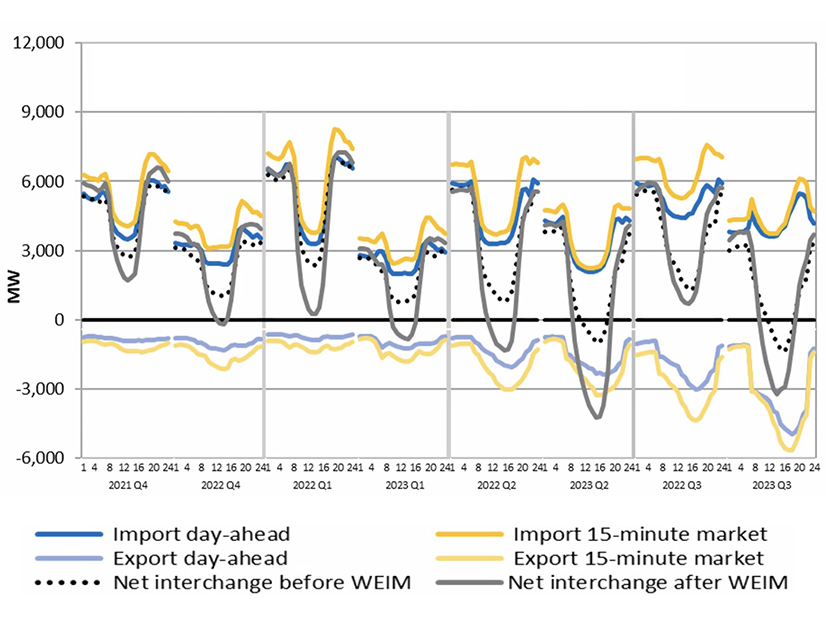
High levels of self-scheduled exports out of CAISO’s balancing area to support stressful conditions elsewhere led the ISO to declare Level 1 energy emergency alerts in late July, the Department of Market Monitoring explained last week.
The alerts, issued for July 20, 25 and 26, were not related to bad weather conditions in California, but actually in areas to its north and south, said Ryan Kurlinski, senior manager of market and policy analysis with the DMM.
Typically, during peak net load hours in the summer months, power flows from the Northwest into the rest of the system. But this July saw relatively low hydro conditions in the Northwest compared with relatively high ones in California. This was coupled with extremely high temperatures in the Southwest that lasted even after peak net load hours, leading to record demand there.
“What we saw this year was a significantly different pattern from previous years,” COO Mark Rothleder said. “What we saw was a higher level of exports and demand outside of our system, and for a large period of time, we could support that demand, but there were times … where we could not.”
When the EEA was declared on July 20, CAISO operators had not yet identified exports they were unable to support in the hour-ahead market. As solar began ramping down, there was still relatively high demand across the system between 6 and 8 p.m. Throughout the day, CAISO had sufficient bids from its contracted capacity to cover its own requirements, but beginning around 8 p.m., “the addition of the exports required CAISO to rely on bids from resources not contracted to serve CAISO load,” Kurlinski said.
While the ISO was close to being unable to deliver exports that had received hour-ahead market schedules, operators ultimately did not curtail any load.
On July 25 though, CAISO was unable to award several thousand megawatts of self-scheduled exports between 6 and 9 p.m.
“I’m calling that the first significant market issue impacting WEIM [the Western Energy Imbalance Market] in this period,” Kurlinski said. “CAISO did not give hour-ahead market awards to all exports that wanted to self-schedule in the hour-ahead market.”
Each of the three real-time markets have a load forecast that the market solves for, and operators frequently adjust this load above the forecast, particularly during net peak load in the hour-ahead and 15-minute markets to cover any uncertainty over available supply. Uncertainty materialized quickly on July 20, Kurlinski said, and by July 25, operators began dramatically increasing the load adjustment.
“These large hour-ahead market load adjustments contributed significantly to the large quantity of exports attempting to self-schedule out of CAISO that did not receive hour-ahead market awards,” Kurlinski said, but “CAISO operators did actually end up allowing a decent portion of these exports to tag … and ultimately flow to other balancing areas.”
Not enough supply could prevent the hour-ahead market to self-schedule exports, but the load adjustment can also be supplied by advisory WEIM transfers flowing into CAISO’s balancing area. If the transfers don’t flow into CAISO in the five-minute market, however, the ISO may not have enough supply to meet load requirements and self-scheduled exports in the hour-ahead market.
“This concern arose on July 25, and my understanding is that it prompted the CAISO balancing area to start limiting the WEIM transfers into its area in the hour-ahead market,” Kurlinski said. From 7 to 8 p.m., the ISO put a 4,000- to 5,000-MW load adjustment into the market, and while much of it was supported by WEIM transfers in the hour-ahead market, almost no five-minute transfers flowed into CAISO.
On July 26, CAISO started strictly limiting WEIM transfers into its balancing area during peak hours, which marked the second significant issue.
The limit significantly impacted transfers in other WEIM areas, such as in Arizona, where transfers to CAISO from Arizona Public Service decreased to zero at one point.
Observations and Lessons Learned
Rothleder shared observations that could help the ISO prepare for any similar conditions in the future, should they arise.
“Between the 20th and the 25th, we took the learnings and the observations, and we applied that [in the 7 p.m. hour] on the 26th,” Rothleder said. “This is what triggered us to limit the amount of transfers the California ISO was relying on from others when we were clearing that hour-ahead scheduling process.”
Limiting transfers, he said, helped reduce uncertainty and increase confidence in the ability to serve load. He also highlighted that the load adjustment aided in dealing with additional uncertainty.
Unusual conditions led to the issuing of the EEA, but all things considered, Rothleder emphasized that it was a successful summer overall for the ISO.
“It’s unprecedented that we would be a net exporter in a summer period, but this past July, we saw periods where we were a large net exporter supporting other parts of the West as they were approaching 96% of their record load outside of the ISO,” he said.
While CAISO did enter a few EEA watches and declared the Level 1 alert, it did not have to issue any flex alerts or experience any load-shedding events.
“The system is becoming more complicated, and we’re seeing flow patterns that are significantly different from historical patterns, and this highlights really the need for that coordination and awareness of the constraints that may arise earlier,” Rothleder said. “That’s why we believe things like the Extended Day-Ahead Market provide the vehicle for that strong coordination, awareness and insurance.”

